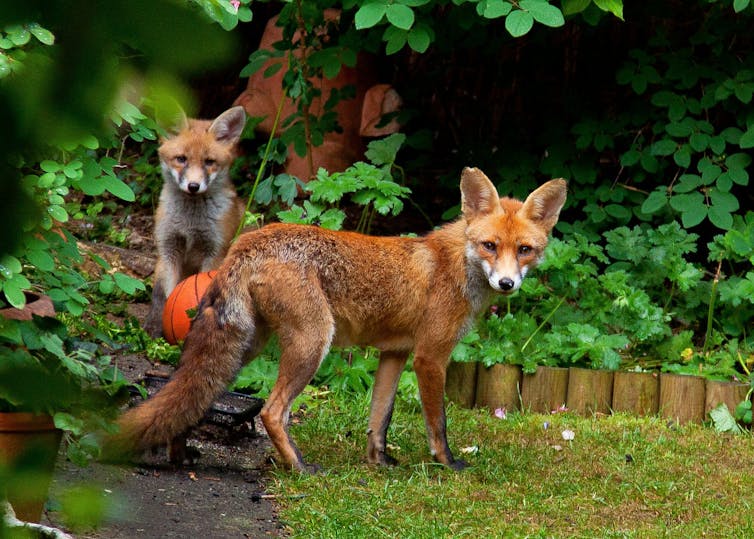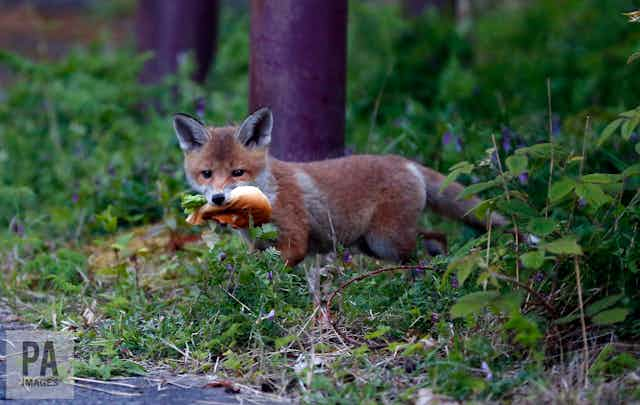Flexible foxes can be found in almost any sort of terrain. Indeed, one species, the red fox or Vulpes vulpes, is the most widely distributed land carnivore of all, ranging from the Arctic to North Africa. And where its rivals stick to the countryside, these foxes have made themselves at home in modern towns and cities. Why is this?
For a start, red foxes are unfussy omnivores. They will eat mice, birds, invertebrates and berries – or your leftover pizza. Our cities are full of potential food for them.
Foxes also benefit from a cat-like agility to navigate around the urban landscape. Their “parkour” abilities mean they can access and exploit more parts of the city than other less agile urban carnivores such as badgers.
No wonder then that foxes have been reported in Britain’s cities since around about the 1930s – and my research has shown they’re now found in more or less every town and city in the UK.
Back in 1995 it was estimated that England had around 33,000 urban foxes but numbers today will be be higher as they’ve since moved into yet more cities. This is in contrast to the UK’s overall fox population, mostly rural, which has declined by 34% over the past two decades – and will fall even further if Theresa May gets her way and repeals the ban on fox hunting.
Many people enjoy the presence of urban foxes and the sense of having genuine wildlife in their gardens. Others however complain about the smell, their poo, or the screaming sounds foxes make when the vixen is calling for a mate during the breeding season.
It is not uncommon for next door neighbours to have radically different views. Often, the main conflict isn’t between humans and fox – it’s between two humans.
Foxes are known to prey on rats and pigeons and so may help to control pest populations. However they can also spread certain diseases which can infect humans, so care needs to be taken over contact with fox poo in the garden by people and pets.
Reports of bites to humans are rare, considering the number of people and foxes living cheek by jowl. They usually arise from the animal being cornered rather than an unprovoked attack, so people shouldn’t try luring them into their houses with food.
Some cities are more fox-friendly than others. As the animals prefer suburban areas to industrial or inner-city areas without gardens, it’s perhaps no surprise that the UK’s highest fox density was recorded in relatively leafy Bristol back in the 1990s. (However shortly after this 95% of the city’s foxes were killed by an outbreak of sarcoptic mange, a contagious skin disease).

More recently colleagues and I estimated the suburbs in Brighton average around 12 foxes per km², which contrasts with the human population density of 3,445/km². We are still working on the data, but it looks fox numbers have increased in recently-colonised cities, while things have remained more stable in cities with well-established populations.
Could the ‘urban fox’ evolve into its own species?
Foxes still move back and forth between town and country. There is sufficient mixing of the population that would prevent the evolution of a distinct genetically separate “urban fox”.
However, foxes in urban areas may be changing their behaviour to adapt to city life. Previous studies found urban foxes still mostly eat “natural” food such as rodents, birds and invertebrates. Human-provided food is only a supplementary part of their diet. However, as more and more people provide food for wildlife in their gardens it is likely that the diet and behaviour of urban foxes may shift towards food provided by humans.
Colleagues and I are now looking at how this extra food will affect fox behaviour and movements. Fox behaviour is directly influenced by how humans act towards them. If people encourage close contact then this will drive tolerance to our presence and if people feed the foxes they will develop an association between humans and food. As populations are typically limited by resources, providing food could be supporting unnaturally high fox densities.
However, foxes also self regulate and it is clear that diseases such as mange have some influence on numbers. This also means that culling foxes has little long-term impact on populations.
Certain personality traits or behaviours may also be advantageous when living with humans and exploiting the urban environment. Individuals that are bolder and can solve problems of how to access food quicker are more likely to be more successful in obtaining food, and thus to reproduce. Over time, these traits may be selected for within urban populations, producing smarter and more courageous foxes. On the flip side, those foxes that cannot tolerate humans are unlikely to thrive in cities and will not pass on their traits to the next generation.
Whatever the future holds for urban foxes, cities provide plentiful food and refuges for them – so they’re here to stay. Love them or hate them, these animals have successfully adapted to the habitats we have built around them, and they are one of a few animals that can tolerate and adapt to our changing behaviour.

